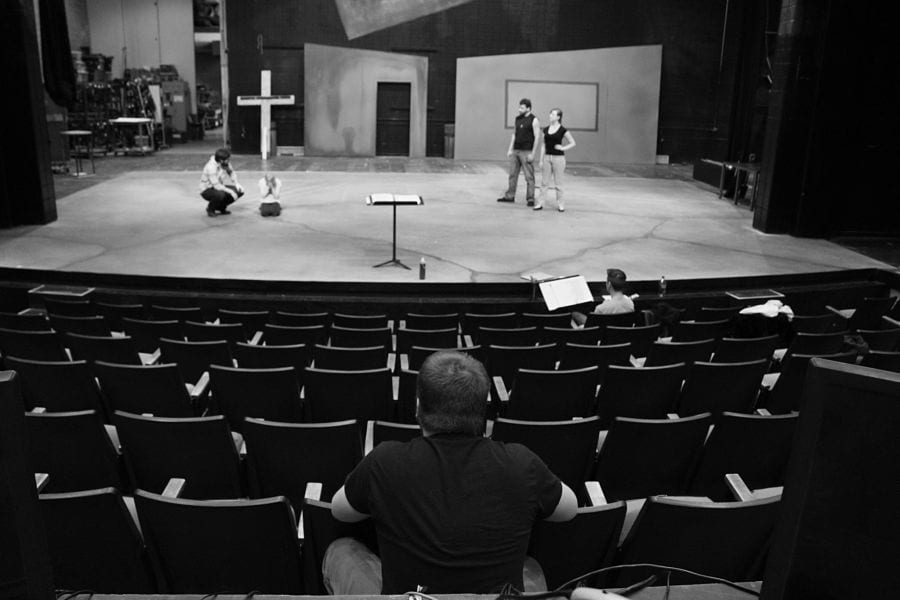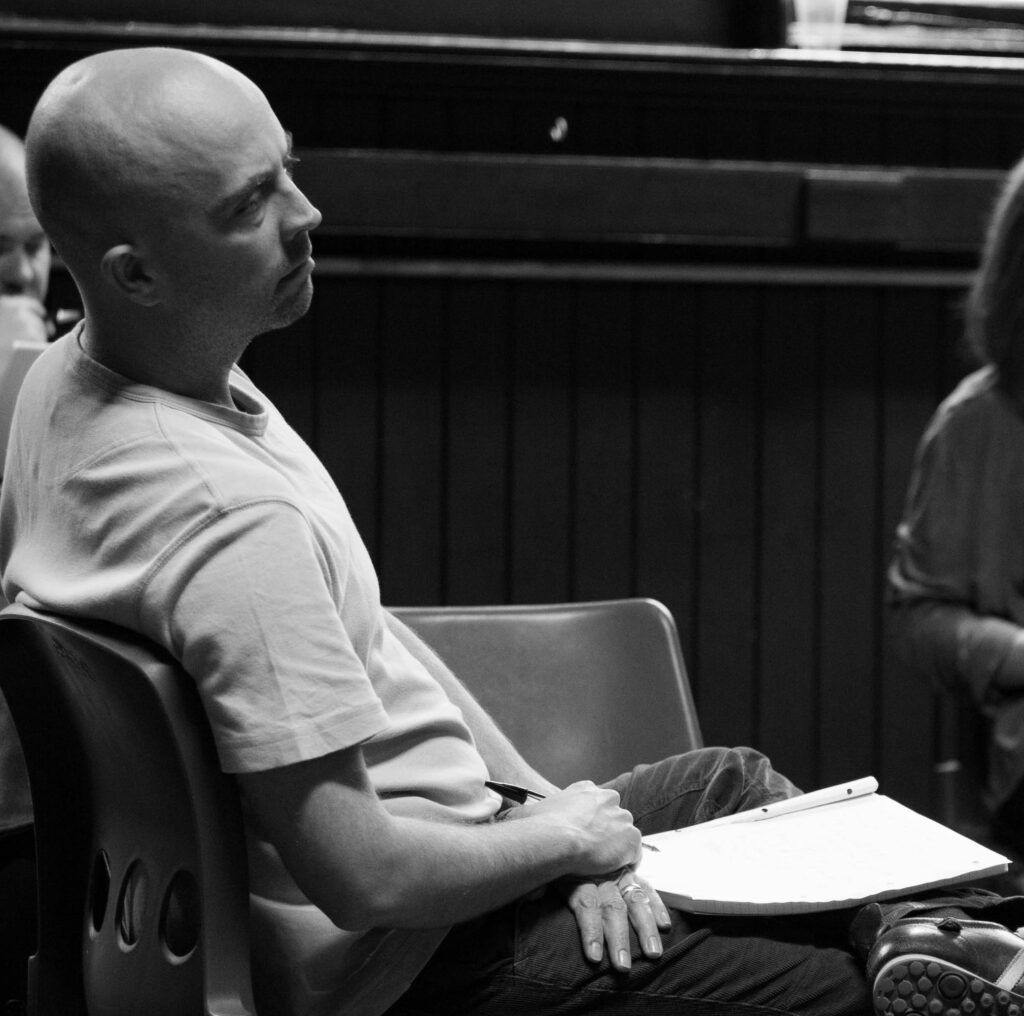This is the first of two blogs to accompany the latest 4D podcast on creative leadership which you can listen to here.
The pace of change today is as slow as it will ever be. The world of work is changing rapidly; creativity, collaboration and communication are becoming ever more important qualities that we look for in our teams. This may mean leading and working together in different ways. How might leaders respond and what models are there for us to draw upon from other fields?
The business world can learn a great deal about how to lead creative teams from the work of theatre directors. Over the last 18 months I have held interviews with theatre directors Sarah Esdaile, Natasha Rickman, Liz Stevenson, Sue Dunderdale and Giles Havergal – all superb theatre directors at different stages in their careers.
From these conversations and building on my own knowledge and experience of both worlds, there are 8 Principles that hold true for leading teams of actors and also have great relevance in other fields. The first four are here and the second four will follow in a blog later this month Enjoy!

1. Leading, Not Controlling
Sarah Esdaile: “The misconception is that you are a puppeteer. That you are a controlling choreographer, and everyone sits and nods and writes down what you say and does it! Actually, the political complexity of leading and inspiring and collaborating is not what people think it is – they think it’s about ruling with an iron fist and asserting and controlling and it’s far more nuanced than that. It’s about empowering people to do their best work, making people want to do their best work and making the whole greater than the sum of its parts.”
The best directors create an environment where each member of their team is working hard and able to express themselves, experiment and takes risks. This enables the director, rather than simply imposing their will, to edit from the work created in the room with the actors.
That requires a deep level of confidence as a leader – to ask a team to trust you to lead them even though you can’t be sure exactly where you’ll end up, or the route you’ll take!
Similarly in business, as Daniel Pink argues, the key drivers of motivation are Mastery, Autonomy and Purpose. If we micro-manage people, preventing them from owning the ways they will achieve their objectives, we stifle their ambition and energy. Simply telling them what to do or how WE would do it teaches them little about how they might approach a similar problem in future. It also stifles purpose – reducing what might have been a successful team endeavour into what could look like simply a way to make the boss look great.
However actors, like employees in other fields, often seek specific instructions from the leader on how to approach a challenge or solve a problem (in acting perhaps, how to say the line or where to move). If they are given the answer they are ‘safe’ – they have done the ‘right thing, and they don’t have to go through the challenge of exploration and experiment. Unfortunately, this approach rarely delivers anything alive and interesting, instead, we get ‘result acting’ – often tired and cliched.
In business too, the employee who is given all the answers is not helped to develop, and the leader is swamped with a constant need to provide answers and affirmation. To counteract this ‘result acting’ it is vital that the director does not direct on the basis of results. Instead, we keep encouraging actors to play, to push, to experiment and to continue to commit to the rehearsal process.
For the business leader looking to foster more creativity in their business there are a number of parallels to be drawn:
- How can we foster an atmosphere of creativity where employees won’t simply reach for the simplest solution or the way things have always been done?
- How might we reward individuals who are trying new approaches, who are looking to tackle problems in new ways?
- How might we use technology to encourage greater collaboration?
- How will the culture of the organisation deal empower those questioning orthodoxy?
- How will we encourage play, curiosity and humour?
The challenges of the future demand more creativity and collaboration – this is at the heart of how the theatre works.

Giles Havergal: “Although one is totally in charge, I feel much more that I’m working with people rather than that they’re working for me and that is actually how I feel about running a theatre or running a business. I think you get a better response.”
2. Motivating with Vision
Natasha Rickman: It’s about having a clear process the actors can then prepare for and know what’s going to happen
There is an idea that directing is about moving actors around the stage and telling them how to say the lines – this could not (now) be further from the truth.
Acting is a joyous but also scary thing to do and this can lead actors of all ages and experience levels to seek to fix a performance and to get it ‘right’. However, this approach to acting rarely delivers anything truly alive and interesting – it too often leads to cliché and, in the worst cases, over-acting, where the actor strives for an emotional pitch, but with little grounding in truth. In business that might mean the same old solutions to problems – turning out an unimaginative marketing campaign, sales incentives or partner kick-offs – because everyone is too busy, lethargic, or simply uninspired, to try anything new.
To counteract this ‘result acting’ it is vital that the director does not direct on the basis of results. Rather they keep encouraging actors to play and to explore, keeping the performance alive by continuing to commit to the rehearsal process. And it is vital through all of this work that the director assumes ‘best endeavours’ – the premise that everyone is doing their best to improve and achieve excellence.

For the business leader, there are a number of lessons to be learned. Most obviously, how can we foster an atmosphere of creativity and freedom where employees won’t simply reach for the simplest solution or the way things have always been done? How can we set a clear process that will get us to the goals we seek; so that individuals have a degree of autonomy over their performance and can focus on what is in their control.
Sue Dunderdale: They have to have confidence in you. You have to be both an equal and the leader or focal point. We are doing equally important tasks just different, but if you don’t fulfill your task of having a structure to work from, having a focus in the room of creating an atmosphere that releases them and relaxes them they’re not going to get anywhere.
3. Creating Trust
Sarah Esdaile: I think a lot of directing is about trust. It’s about showing, not telling. I’m deliberately emotionally open which makes people feel safe and that’s partly my personality and that’s partly practical. I think that makes people trust me and I have an emotional vulnerability, as well as toughness. What I aspire to is being able to say, “Oh god don’t do that you look like a ****” and that’s absolutely brilliant for both of us.
The director creates a place of trust where actors can be freed from self-limiting beliefs and self-consciousness to play, stretch themselves and learn from failure.
The rehearsal process demands that actors take risks – sometimes emotionally, but most often trying ideas where they make look or feel daft. They have to play with what is possible to get beyond obvious and cliché. The director rewards this commitment to play and risk to encourage yet more fearlessness from that actor and their colleagues – they reinforce the behaviour with praise and by building on the actors’ ideas.
The director has to foster a team dynamic quickly. Unlike in business where the leader is often working with a team for years, in the theatre, the director brings together a group of actors, often with vastly different life and acting experiences, and has to rapidly form them into a functioning team.

This can’t be achieved with a few trust games or an away day building rafts (although that might be fun!) Instead, the director has to quickly help the team to collectively agree on goals. In the theatre, this means most obviously having the production ready for ‘opening night’ but can incorporate much more than that. The measures of success may be far wider than full houses – perhaps what we learn as a group about acting and ourselves, what new understanding we achieve about the play or our world.
In the same way, in business, there’s a revenue, market share or profit number to be hit, but we can also create richer and deeper goals to increase the sense of team purpose and achievement. The work of Simon Sinek here is especially instructive.
We might create a Team Charter or a Team Alliance to align on what behaviours and attitudes will get us to our stated goals.

In the theatre, once we have a clear sense of the team’s goals and purpose the director can focus the team on building towards those goals. They will take care to ensure the room is a ‘safe’ environment where people are free from humiliation, encouraged to try new things and to take ownership of their own performance. There is little more damaging to fostering a strong sense of trust than fear. A culture of fear can result in team members vying for position, when their ego becomes more important than the collective endeavour, whilst others may simply disconnect from the process and stop contributing.

However, a safe environment should not mean no disagreements – indeed, healthy conflict is vital to driving the team on to create their best work. Once we are all clear on the goal and have a sense of trust robust discussion can be channelled in service of getting the best result for the team.
As a leader what space do you give to new ideas? How do you celebrate when people try new things (even if they aren’t always successful)? How might we reward individuals who are trying new approaches, who are looking to tackle problems in new ways? Can your team have challenging discussions without damaging their relationships?
Liz Stevenson: Admitting errors reassures actors. It also creates an environment where people can fail and I think it shows an element of confidence in your leadership, that you can criticise yourself; that you can say I don’t know, but it’s ok and we don’t need to panic – we will find a solution.
4. Intentional Energy
Sarah Esdaile: I think part of the leadership is for you not to be the hero, for them not to know all the work that you’re doing. It’s like being a duck swimming along not knowing all the shit you’re dealing with. It’s not my job to overload them with all the crap that I’m dealing with – it’s my job to liberate them.
The good director, like the good leader in sporting, military or business fields, needs emotional control and patience. These are vital in the projection of authority. The director’s energy is the most crucial in the room, she understands that her energy provides an example to the team and so cultivates the ability to excite with enthusiasm and engender calm in a crisis.
A positive, engaged and calm presence is vital to settle the team and help them to understand that you are in control and able to cope with any of the challenges thrown at you. The actor can then relax and concentrate on their performance. It is a simple and effective way of communicating to the cast what energy is expected of them and of the atmosphere that one wishes to work in. It is the classic show, not tell.

In business too, uncontrolled swings in mood and energy can have an unsettling effect. When times are tough the team will look to the leader to assess the situation and react calmly and confidently. We cannot think clearly when in a state of very high emotion and a team cannot function effectively if they worry their leader will panic.
By cultivating a sense of emotional control and patience the leader can engender confidence in their team and help ensure they are in the right state of mind to give their best creative work.
Whilst some people are more naturally ‘calm’ than others, a heightened awareness of our physical and emotional impact is crucial for the leader and is at the centre of the work we do at 4D. Whether it is your breath, voice, posture or gestures you have far more power to control the energy you project into the world than you may believe.
Liz Stevenson: It is important because your energy, your mood filters through to everybody in the room so if you’re really stressed and unhappy and frustrated they will pick up on that and you can’t always help the way you feel. You’re a human being, but you should make a conscious effort to stay calm. If you blow up and say what you’re thinking sometimes it can have a really damaging effect that means they won’t trust you so I think you’ve got a responsibility to stay calm.
The team at 4D have over 50 years of theatre experience, coupled with strong business backgrounds; we have a passion and expertise for Psychology and a practice grounded in Integral Theory.
Through our work on Communication, Wellbeing and Team Performance we bring simple and clear tools combining our experience to businesses across the world. If you’d like to explore how the 4D tools can help bring these principles to life for your team, please contact Matt Beresford on matt@4dhumanbeing.com


